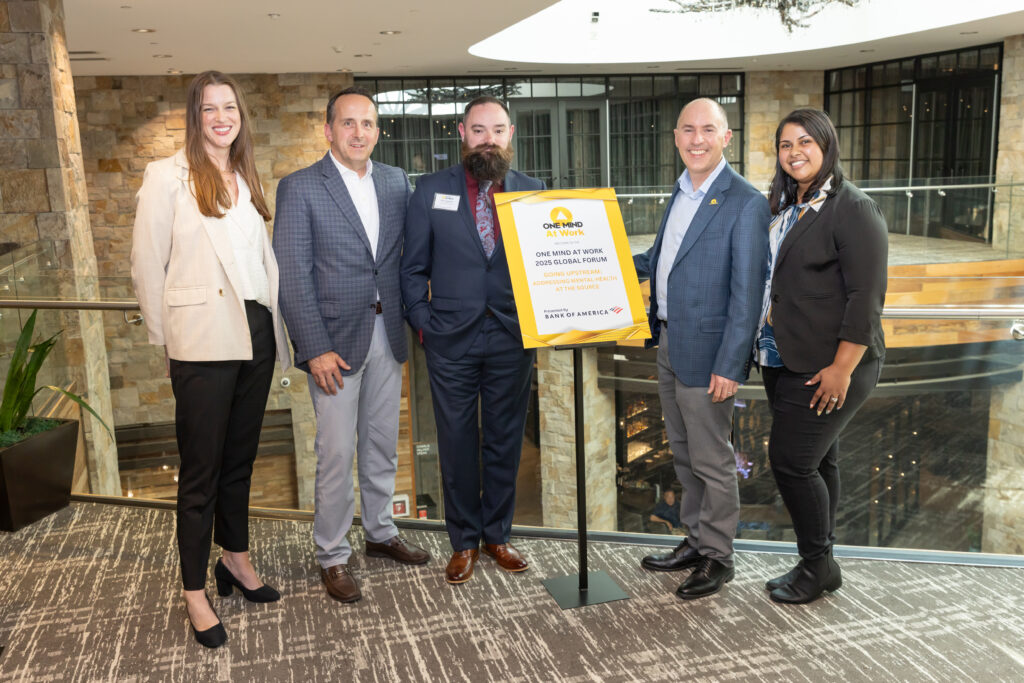Turning Glass Houses into Lighthouses: Overcoming Workplace Stigma
by Brandon Staglin, One Mind Lived Experience Council Chair

(Left to right: One Mind Lived Experience Council Members, Linea Johnson, Scott Kelsey, Alex Sheehan, Brandon Staglin (Chair), and Uma Chatterjee at the 9th Annual One Mind at Work Global Forum)
Of Glass Houses and Glass Ceilings
One of my favorite rock artists, Billy Joel, once made a daring statement about challenging the status quo. He said about his breakthrough album Glass Houses, “The old thing about people who live in glass houses shouldn’t throw stones—I don’t believe it. I think, ‘Why not? Take chances.’ I really wanted to throw a rock at my own house.” ¹
Recalling my early career, Mr. Joel’s quote reverberates in me like a skylight pummeled by hailstones. Working in the 1990s at a large Silicon Valley engineering firm with undisclosed schizophrenia, I felt I was living in a glass house–fearful that if people saw evidence of my illness, it could shatter my career–and too afraid to challenge the stigma entrenched in the status quo. In fact, when my illness flared up after four years of “hiding it” on the job, that promising career did shatter–I had to resign, forfeit my graduate school admission, and retreat to a psychiatric hospital. As I languished for years, I believed no one should have to endure such a life-crushing blow. If my workplace had openly offered support for its workers with mental illness, my life might have taken a very different path.
Today, I still believe that, and it has inspired a core focus of my career ambitions. The evolution in my career has enabled me to advance beyond those early fears, to a brighter vision of how workplaces can be. The status quo can change–but not by throwing stones. Instead, by shining light through the walls–illuminating the humanity of us all, across the spectrum of mental health–we can change how employers treat workers with diagnoses–and enable us to beam through glass ceilings.
To ignite such a light, under my direction, One Mind is developing a program called Launchpad, which will help workplaces to successfully hire, retain, and grow the careers of young workers with lived mental illness experience. Our Launchpad Project Lead, Priya Chirayil, and I, have conducted research with both employers and young adults with lived experience to guide the development of our program to satisfy both. As we have learned, the status quo is ugly – but holds potential to improve.
Workplace Discrimination Is Pervasive and Pernicious
Despite years of progress in which American attitudes about “mental health” have gradually normalized, workplace stigma and discrimination continue to hold back workers with mental illness from achieving the careers they deserve. Early on, our research confirmed a pervasive uphill battle for such workers, revealing four obstacles to career advancement, all based in stigma.
- Workplace accommodations don’t track the needs of the worker. When workers first ask for accommodations (such as flexible work hours) to stay productive, their supervisors usually grant them, as the Americans with Disabilities Act mandates. However, too often such accommodations are provided as a “box check” after which supervisors fail to check with their workers about their evolving needs. One worker mentioned that when they requested updates to their accommodations, their supervisor framed their request as a “preference, not a need.”
- Disclosure of one’s condition is frightening. As one worker confided, “I’ve always been an advocate that wants to disclose, but I have to say, even lately, I’ve been kind of scared.” Too many workers are afraid to live openly with their conditions–which can prevent them from seeking support while stifling their social development among their colleagues.
- Co-workers disrespect their peers with mental illnesses. Workers with lived experience have reported that they (and their illnesses) have been scapegoated for adverse workplace outcomes. As one worker said, “With mental illness, you know, it’s a chance for them to talk about you…to say that’s why he was ‘a jerk,’ or why he was like that.”
- Underestimates of ability undermine career growth. One worker related, “My biggest challenge is overcoming the presumption that you’re incapable, even from loved ones or mentors.” Because supervisors don’t perceive their workers’ potential, they don’t offer promotions to more responsible, rewarding roles.
Due to these factors, it is all too typical for workers to encounter crises that make them leave their jobs, restarting at employer after employer in discouraging, vicious cycles.
How to Overcome Workplace Stigma
So how do workers living with mental illness rise above glass ceilings while living openly with their conditions? I believe that only light can dispel darkness, and the brighter, the better. Individual actions, conducted with care, can shine that light, while support from colleagues and workplace leaders can manifest the necessary culture in which workers with lived experience can thrive as their most productive selves. Here are some actions stakeholders can take, supported by my own experience, our One Mind Launchpad research, and the experiences of member organizations of our One Mind at Work program.
Individual Actions
Workers with lived experience can leverage their strengths to build workplace reputations as valuable, relatable contributors. If you are a such a worker, understand that your listeners might fear mental illness, due to the pervasive stereotyping in our culture. Help them feel comfortable and even inspired by framing your diagnosis as a strength. Show examples of how your neurodivergence and your handling of adversity have instilled vital qualities in you–as research has shown, people with mental illness self-report a range of such workplace assets such as attention to detail, creative problem solving, and fierce compassion.² Share stories focused on the values your experiences have taught you as touchpoints for common ground.
Allies’ Actions
If you manage or work with someone with mental illness, keep your eyes, mind, and heart open as you relate to them, as this is the best way to appreciate them as the unique human beings they are. Include your colleagues with mental illness as peers in workplace social activities. Approach any unusual social interaction styles you observe curiously and nonjudgmentally; though your colleagues may relate to others differently, they are human like you. As a manager, you can support your co-worker to build their strengths and access growth opportunities such as mentoring by others in your organization with lived experiences.
Leaders’ Actions
If you’re an executive, commit to making your workplace a zone of belonging, broadcast that commitment frequently, and “walk the talk”. First, address your organization’s culture. Ensure that it embraces people with mental illness experience as part of the team. Start by immersing yourself in learning led by people with lived experience, and exposing your managers to such education. Learn to share effectively about your own mental health experiences, and teach your teams to do the same. The more such storytelling spreads (including in conversations about serious mental illness), the more “normal” such experiences will feel. Establish training for managers at all levels on how to bring out the best in their workers with lived experience. Facilitate your teams to form interdepartmental task forces (in the style encouraged by Damon Centola’s Change: How to Make Big Things Happen) to co-develop employee resource groups, ambassadorships, mentorship programs, and more. Through our Launchpad program, we at One Mind plan to assist employers to establish lived-experience friendly workplaces, as lighthouses to guide others to join in.
With courage and support, meaningful careers can be attainable while living with a mental illness. I share this story to illuminate the potential to make such thriving the norm throughout our society’s workplaces. What about you? As an individual with lived experience, an ally, or a workplace leader, how will you add your fire to shine such potential for others? As more such fires ignite within workplace cultures, those fearful glass houses will become welcoming lighthouses–and we can start to build the inclusive society we all deserve.
Sources:
¹American Songwriter, “The Meaning Behind “You May Be Right” by Billy Joel and that Breaking Glass at the Beginning of the Song”, 2024
²Sophie Hennekam, Kayla Follmer, Joy E Beatty. The paradox of mental illness and employment: a person-job fit lens. International Journal of Human Resource Management, 2020, pp.1-28. ff10.1080/09585192.2020.1867618ff. ffhal-03232758f
